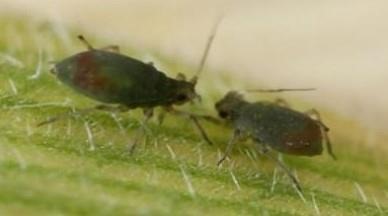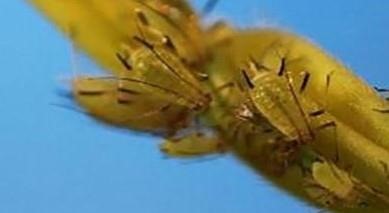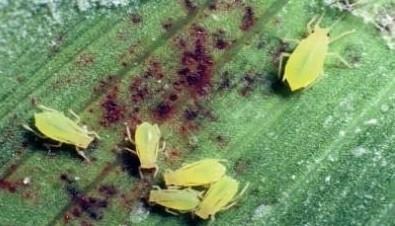By Adam Varenhorst
This week we received the first report of aphids in wheat for the 2021 season. At this point in time, the populations are well below the economic thresholds (Table 1). The populations won’t be increasing rapidly until the daily temperatures warm up a little, but it is still a good idea to scout fields and determine if aphids are present.
Aphid Identification
BIRD CHERRY OAT APHIDS
Bird cherry oat aphids can vary in color from olive to dark-green and can be identified by the characteristic burnt red-orange patch that is present on the end of the abdomen near the cornicles or “tailpipes” (Figure 1).

Figure 1. Bird cherry oat aphids.
ENGLISH GRAIN APHIDS
English grain aphids can vary in color from light or dark green to brown, and they can be identified by characteristic black antennae, cornicles and leg joints (Figure 2).

Figure 2. English grain aphid.
GREENBUGS
Greenbugs are a species of aphids that are light-green in color and can be identified by the dark-green stripe present on their back. Feeding by this species causes yellow discoloration and red spots on the leaves due to a toxin present in its saliva (Figure 3).

Figure 3. Greenbug.
Scouting Wheat for Aphids
The easiest way to scout for wheat aphid populations is to start at one side of the field and walk in a “W” or zig-zag pattern. While walking, randomly choose 20 plants from each leg of the pattern and examine them for aphids. During the spring, the aphids are most commonly observed on the leaves and stems of the plants. Table 1 contains the economic thresholds for the three aphid species. If populations exceed the thresholds, please refer to the most-current edition of the South Dakota Pest Management Guide - Wheat.
TABLE 1. ECONOMIC THRESHOLDS FOR APHID PESTS OF WHEAT.
| Pest | Number of Aphids Per Plant |
|---|
| | Seedling
Stage | Boot to
Heading Stage | Flowering
Stage | Milky Ripe
Stage | Milk to Medium
Dough Stage |
| Bird Cherry Oat Aphid | 20 | 30 | >5 | 10 | >10 |
| English Grain Aphid | 30 | 50 | 5 | 10 | >10 |
| Greenbug | 5–15 | 25 | >25 | >25 | >25 |
Source : sdstate.edu